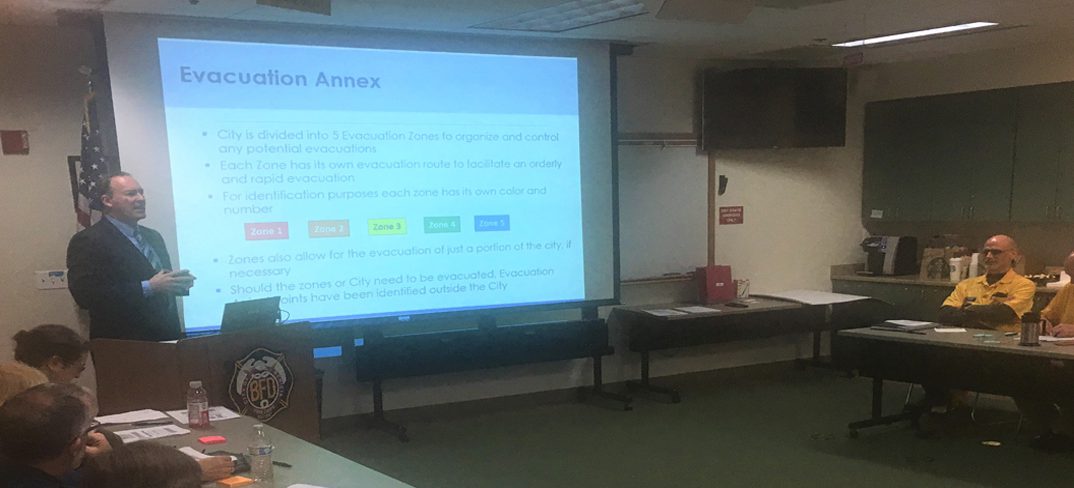
Planning
COMPREHENSIVE PLANNING
Our collaborative planning process allows Federal, Tribal, State, County, and Municipal governments and agencies, Special Districts, Institutions of Higher Education, Non-governmental organizations, and the business community to review current best practices, follow and meet the standards and guidelines established by FEMA, CalOES, and OSHA, and engage with the whole community to ensure your plan is comprehensive and inclusive.
We work with representatives from your agency or organization and other select stakeholders representing the whole community, to author a current and comprehensive Emergency Operations Plan, Hazard Mitigation Plan, or Continuity Plan.
Emergency Operations Plan
The Emergency Operations Plan (EOP) addresses your agency or organization’s planned response to extraordinary emergency situations associated with natural, technological, and human caused emergencies or disasters. This plan is the principal guide for your agency or organization’s response to, management of, and recovery from real or potential emergencies and disasters occurring within its designated geographic boundaries or sphere of influence
The plan applies to extraordinary emergency situations associated with any hazard or threat, be they natural, technical, or human caused, which may affect your agency or organization and that generates situations requiring planned, coordinated responses by multiple agencies or jurisdictions.
The FEMA “Comprehensive Preparedness Guide 101” is the standard for Emergency Operations Plan guidelines and recommends a whole community approach to planning. We will assist your agency or organization in establishing a Core Planning Team who will assist in the creation of this Emergency Operations Plan. The Core Planning Team will include representatives of your agency or organization, key community or industry partners, and other identified stakeholders representing the whole community. This plan will meet all California State Standardized Emergency Management System (SEMS), Federal National Incident Management System (NIMS), Federal Clery Act, and State and Federal Occupational Safety and Health Administration (OSHA) requirements and mandates along with the “EOP Crosswalk for Plan Review” as outlined by the California Governor’s Office of Emergency Services (CalOES).
Hazard Mitigation Plans
Hazard Mitigation is the ongoing effort to prevent or lessen future emergency or disaster incidents, and the impacts they might have on people, property, and the environment.The Multi-Hazard Mitigation Plan provides a comprehensive listing of actions that may assist Cities, Counties, Special Districts, Institutions of higher education, and public and private sector organizations in reducing risk and preventing loss from future hazard events.
“Under the federal Disaster Mitigation Act of 2000 (DMA2K), each municipality must develop a Local Hazard Mitigation Plan (LHMP) or participate in a multi‐ jurisdictional LHMP in order to be eligible for pre‐ disaster mitigation grants or post‐ disaster recovery assistance from the federal government. At the state level, AB 2140 (2006) authorizes local governments to integrate their LHMPs into the safety elements of their general plans. Such integration is not mandated by this law. Instead it is encouraged through a post‐ disaster financial incentive which authorizes the state to use available California Disaster Assistance Act funds to cover local shares of the 25% non‐ federal portion of grant‐ funded post‐ disaster projects…” (State Of California Multi-Hazard Mitigation Plan, 2013)
Dam Emergency Action Plans
The Emergency Action Plan (EAP) addresses the planned response to an actual or threatened extraordinary incident, disaster, or emergency associated with a Dam. The EAP defines response roles and responsibilities, provides incident detection and emergency notifications protocols, and provides procedures designed to identify unusual and unlikely conditions that may endanger the Dam in time to take mitigative action and to notify the appropriate emergency management authorities of possible, impending, or actual failure of the Dam. This EAP may also be used to provide notification when flood releases can create major flooding.
Continuity Plans
An effective continuity program is implemented through its related continuity plans and procedures and an operational capability to support those plans and procedures. Continuity planning is an effort to document the existence of, and ensure the capability to continue essential functions during a wide range of potential emergencies or disasters.
Continuity plans enhance organizational/community resilience that plays a critical role in managing threats to essential business functions from all-hazards. Resilience can be defined as the ability of an organization/community core business functions to rapidly adapt and respond to internal or external dynamic changes, business opportunities, demands, disruptions or threats.
Continuity resilience must encompass business as well as information technology operations and recognize the importance of partnerships and interrelationships. It should encompass Strategic planning and procedures; Organization/community; Core business processes; Communications and information technology; Essential/vital records; and Facilities and security.
